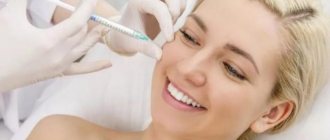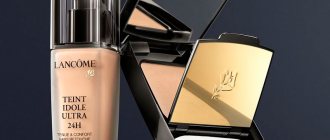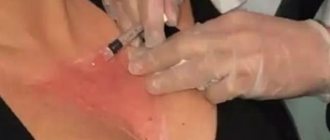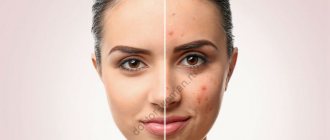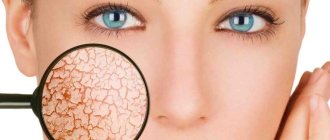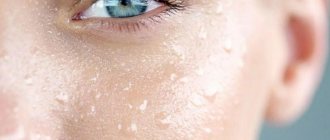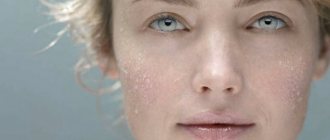If the skin does not look very fresh and healthy, if there are problems on it, then such skin is usually called problematic. Problematic skin can affect anyone at any age. If your skin is perfect when you are young, it may deteriorate later. Hormonal changes greatly affect her condition. In addition, if you experience stress, if there are many other unfavorable factors in your life, your skin condition will worsen. Skin can be dry, oily, or combination. Skin types are also distinguished by age. This is young skin, mature, or aging. If a person turns to a dermatologist, then most often he turns to him with problem skin.
Problematic facial skin: causes
The content of the article
Various factors can negatively affect the health of the skin. Especially often these are pathologies of internal organs, infection with fungus, herpes, staphylococcus, and the attachment of ticks. Under the influence of external factors (stress, poor diet, smoking, solar radiation) the protective function of tissues also decreases. This often manifests itself as cosmetic defects in the facial area.
To effectively deal with the problem of skin rashes, you need to establish the cause of the unpleasant symptoms. In adolescence, imperfections in the form of acne, greasiness or dryness in 90% of cases are associated with the characteristics of puberty. But after 20 years, rashes are a clear sign of health problems.
The following pathologies lead to the appearance of rashes:
- Hormonal disbalance
. In particular, excessive acne is observed with elevated testosterone levels. Acne in women can appear during certain phases of the menstrual cycle. For example, a few days before your period. - Weakening of the immune system
. Junk food, UV radiation, abuse of alcohol, tobacco, and cosmetics reduce the protective ability of Langerhans cells. - Disorders of the gastrointestinal tract.
Digestive disorders are accompanied by intoxication of the body, which is associated with stagnation of food in the stomach. Toxins accumulate in cells and are eliminated through the skin. When removing toxins, the ducts of the sebaceous glands become clogged, which causes inflammation. - Allergy
. This is a hypersensitivity reaction to an irritant, which manifests itself in rashes of various types. - Genetic predisposition
. Problems with hormones, the functioning of the sebaceous glands, and the toxic composition of sebum are often inherited.
Uneven skin color
Among the causes of this condition, the most important is not skin aging, but a person’s prolonged exposure to the sun or regular visits to solariums. Uneven skin color also occurs when microparticles are deposited in the skin due to environmental pollution, after taking certain medications, with hormonal fluctuations, against the background of chronic inflammation, diseases of internal organs, vascular pathologies, disturbances in the microbial composition of the skin, etc.
Uneven skin color manifests itself as areas of hyper-, hypo- or depigmentation, focal or extensive changes in shade ( Fig. 3 ). Find out more about uneven skin tone and how to correct it here.
Rice. 3. Uneven skin tone due to rosacea (Skin and Lasers Surgery Specialists)
Signs of skin problems
Treatment of facial skin is necessary when the following symptoms appear:
- constant formation of inflammatory foci - acne, pimples, comedones;
- fat content of the upper layer of the epidermis;
- peeling of the skin on the face in men and women;
- age spots, freckles;
- hyperemia of the skin;
- itching and redness;
- blackheads, enlarged pores.
Freckles
Dark spots
Treatment of facial skin for acne and other cosmetic defects is a long process. Cosmetic procedures often turn out to be ineffective. Therefore, at the first signs of pathology, you should consult a doctor. The doctor will help determine the cause of the rash and select effective treatment methods.
Wrinkles around the eyes
This is a clear sign of aging of the facial skin around the eyes of varying degrees of severity - from fine lines to large creases. Their main causes are chrono- and photoaging. A significant aggravating factor is smoking, which enhances the destructive effect of matrix metalloproteinases on extracellular matrix proteins (collagen, elastin) and contributes to the earlier appearance of wrinkles around the eyes.
One of the classifications of periorbital wrinkles is the following ( Fig. 4 ):
- Type I - wrinkles extend from the outer edge of the eye to the eyebrow and zygomatic process.
- Type II - wrinkles extend from the outer edge of the eye to the zygomatic process.
- Type III - single wrinkles are limited to the outer edge of the eye.
Find out more about wrinkles around the eyes and how to treat them here.
Rice. 4. Types of periorbital wrinkles (Tamura BM, Odo MY Classification of periorbital wrinkles and treatment with botulinum toxin type A. Surg Cosmet Dermatol 2011; 3(2): 129)
https://www.surgicalcosmetic.org.br - page 131, figure 2
Hyperkeratosis of the facial skin: what it is and treatment
Hyperkeratosis is a thickening of the stratum corneum of the epidermis, as a result of disruption of the processes of cell division and desquamation of dead particles. With this disease, bumpy facial skin, dehydrated areas, and severe peeling are observed. Hyperkeratosis often develops as a concomitant pathology of the underlying disease:
- diabetes;
- psoriasis;
- lack of vitamins, minerals;
- fungal infection.
Therapeutic tactics are aimed at eliminating the underlying disease. Moisturizing creams, chemical peeling procedures, and mesotherapy are used as symptomatic remedies. Cryotherapy and microdermabrasion are also effective.
Drugs that increase the exfoliating ability of cells demonstrate effectiveness. This group of medications includes ointments based on retinoids. In case of severe inflammation, non-steroidal drugs are prescribed to relieve hyperemia and itching. To boost immunity and improve overall well-being, it is recommended to take vitamins.
Accurate diagnosis of signs of aging and results of aesthetic procedures
Accurate diagnosis and reliable confirmation of the results of aesthetic interventions are coming to the fore today. This approach to assessing the signs of skin aging allows not only to make a correct diagnosis, but also to document the results of the procedure, which is significant evidence of the success of the cosmetologist. To do this, you can use a three-dimensional modeling system - for example, Antera 3D .
Antera 3D consists of a high-definition camera with a special housing that blocks outside light from entering the shooting field. There are LEDs around the camera lens; when shooting, they turn on alternately, illuminating the skin in different spectral ranges. In a few seconds, more than a hundred photographs are taken in different lighting conditions, from which a computer algorithm models a three-dimensional photo.
Features of the Antera 3D three-dimensional modeling system :
- Skin texture - the degree of uniformity and smoothness.
- Wrinkles - linear dimensions, depth, severity index.
- Hypertrophic scars - volume, area.
- Deep wrinkles and furrows - precise localization, depth measurement.
- Skin neoplasms - volume, area, shade.
- Pores - number, severity index.
- Melanin - uniform distribution, skin tones.
- Hemoglobin - uniformity of distribution, content in the skin.
Several versions of Antera 3D allow you to choose the tool that suits a particular specialist.
Dehydration of facial skin: causes and treatment
Water is a natural environment for the biochemical processes of cell division and vital activity. When there is not enough water resource, the protective ability of the skin decreases, and the risk of penetration of harmful substances and microorganisms into the epithelium increases. Therefore, imperfections and dermatological defects may appear in the facial area. People with any type of epithelium (oily, dry, combination) can suffer from dehydration.
Dehydrated skin
Signs of dehydration of the epidermis:
- dullness of the skin;
- deepening existing wrinkles and facial furrows;
- constant feeling of dryness;
- peeling, areas of irritation;
- decreased elasticity of the epidermis;
- constant feeling of tightness;
- coarsening of the epidermis;
- small rashes on the nose, forehead, chin.
Under the influence of external factors and metabolic disorders, the epidermis loses its ability to retain moisture. At the same time, the acid-base balance changes and collagen production decreases. However, a violation of the water balance is a temporary problem, after which the external defects disappear. Treatment of facial skin dehydration is based on eliminating the provoking factor or underlying disease associated with metabolic disorders.
The problem of dehydration can be partially solved with the help of cosmetic care, which is selected by a doctor. Care cosmetics should contain fruit extracts, linoleic acid, vegetable oils, and vitamins. If the skin is dehydrated, the use of peeling scrubs, soaps, and products containing alcohol, collagen, and fatty acids is contraindicated. The doctor will most likely prescribe masks, steam baths with extracts of medicinal herbs - chamomile, St. John's wort, lemon balm, eucalyptus. To restore water balance, it is necessary to follow a drinking regime and a diet enriched with vitamins C, B, E.
Problem skin care system
Care must be taken strictly in a certain order. Chaoticity and spontaneity will not lead to the desired result. There are only 4 main points:
- Cleansing. Choose products that suit your skin and age. Avoid cosmetics with aggressive surfactants (soapy base), look for delicate and soft ingredients in the composition. Be sure to cleanse your skin twice a day: in the evening from dust and dirt from the street, in the morning from dust and cream residues on the pillowcase;
- Toning. Standard toners are not suitable for problem skin; look for hydrolates (steam extract from herbs and flowers). Approach your choice wisely and carefully: pay attention to the packaging, expiration date and appearance of the liquid. If something bothers you, it’s better not to take it. Errors in preparation, leaky packaging and expired expiration dates lead to the growth of bacteria and fungi inside the hydrosol;
- Hydration. Choose products that suit your skin characteristics. Look for hyaluronic acid and aloe extract in the composition. This point is very important, even oily skin needs hydration;
- Eating with masks. A one-time and precise blow to the problem. After the masks, the skin is smooth, matte and looks healthy. You can’t do them every day, as there is a risk of over-saturating the skin, which will lead to new rashes.
Rosacea of the facial skin: treatment
Rosacea or rosacea is a chronic inflammatory disease of a non-infectious nature. The pathology is associated with a violation of the tone of blood vessels in the upper layer of the epidermis. As a result, persistent foci of inflammation are formed - acne, ulcers, areas of pronounced redness. Pathology develops especially often in older women and men, usually after 40 years.
Facial rosacea
Medicine knows more than 10 types of rosacea - persistent edema, granulomatosis, fibrous lesions, etc. The disease begins with the periodic appearance of erythema (redness), which disappears after a few hours. Next, the choroid plexuses become visible, a bluish color, papules, and pustules appear. At the last stage, fibrous tissue grows and the oval is deformed.
Doctors take a comprehensive approach to the treatment of rosacea, prescribing effective medications and personal recommendations for caring for the facial area. The following groups of drugs are used:
- Medicinal gels, creams, ointments containing metronidazole, anti-inflammatory, antiparasitic components;
- Antihistamines - to relieve severe inflammation and allergies;
- Vitamins that strengthen the walls of blood vessels;
- Antibiotics - used in case of secondary infection.
Doctors recommend following a diet during treatment and rehabilitation. You should avoid fast food, alcohol, salty, smoked, fried foods, and coffee. It is important to minimize the influence of possible irritants - solar radiation, frosty air, dry wind. Daily care products should not contain fatty acids, alcohol, acetone, or hormonal additives. To treat facial skin in later stages, cryodestruction, laser therapy, and electrocoagulation are used. These procedures help eliminate dilated vascular networks.
Pimples on the forehead. Before and after
This path to clear skin turned out to be short-lived, but it was not without losses. And we lost kilograms of dairy products along the way. It was difficult in places, sometimes you ask for milk in your coffee, sometimes the omelette winks
Of course, we selected therapeutic care and a regimen of external medications. As you can see from the feedback, it turned out that clear skin is worth these efforts, which ultimately become the norm and do not cause problems.
When the skin has cleared, there is no need to relax with either care or nutrition. The tendency to rashes will be with you all your life and your skin will find a reason to remind you of it, believe me.
Yes, it is possible to gradually return products after some time, just in a smaller volume and not all of them. This is discussed with your doctor.
Cosmetologist's work:
- Clean forehead
- Skin without rashes
- Selected care
- External preparations
- Got rid of dairy products
- Will remain prone to rashes
Demodex: facial skin treatment
Demodicosis develops as a result of tissue infection by a subcutaneous mite that lives in the sebaceous glands. The parasite causes disruption of the morphological structure of the skin and the immune status of a person. Infection with Demodex is one of the factors provoking rosacea, seborrheic dermatitis, and acne.
Demodicosis is accompanied by the following symptoms:
- elements of rashes - ulcers, acne, papules;
- continuous hyperemia;
- pale gray color;
- enlarged pores, excessive sebum secretion;
- greasy shine in the light;
- itching, peeling;
- inflammation of the conjunctiva;
- general swelling.
Acne on the face
Treatment of micro-mites under the skin of the face requires an integrated approach with local and general medications. The basis of treatment is antibacterial drugs and agents that reduce sebum production. For local therapy, antiparasitic ointments, gels, and shampoos are used, which disrupt the functioning of the Demodex nervous system.
During the treatment of demodicosis, doctors recommend:
- clean the facial area only with medications prescribed by the doctor or thermal water;
- use dry wipes instead of towels;
- Avoid mechanical removal of pimples and ulcers;
- give up decorative cosmetics, get rid of the products you used before your illness;
- exclude alcoholic drinks and smoking;
- use pillows and blankets with synthetic filling;
- Avoid solariums and sunbathing on the beach.
Pore cleansing
To give up smoking
A diet that limits the amount of carbohydrates and fats alleviates unpleasant symptoms. Lack of fat reduces sebum production, that is, it limits favorable conditions for the parasite. You should avoid spicy foods, fried, salty, smoked foods, and sausages. It is better to boil or steam the permitted foods.
Acne, rashes, comedones. Before and after.
It seems that the degree of acne is not severe, and there are no very bright and painful rashes, but it is still clear that the quality of the skin leaves much to be desired. And the patient is completely dissatisfied with the condition of his face. There are many comedones that periodically become inflamed, uneven relief, the skin sometimes dries out, sometimes becomes oily, it has a gray and uneven color.
The difference between before and after is obvious, the patient is simply delighted that her skin can look good, be so smooth and well-groomed. The efforts consisted of high-quality home care, several foods were excluded from the diet, recommended procedures - cleansing, peeling.
Cosmetologist's work:
- The period between photos is about 1.5-2 months
- Home care
- Selected diet
- Procedures: Facial cleansing and peelings
Oily facial skin: causes and treatment
Oily facial skin is associated with excessive activity of the sebaceous glands. This type of skin requires systematic care, otherwise acne, ulcers, and comedones appear. First, skin defects appear on the forehead, chin, cheeks, and then throughout the facial area. After healing, scars, scars, and rough bumps form at the site of the inflammatory foci. The skin takes on a dull blue or gray tint.
Often, disruption of the sebaceous glands is associated with a genetic factor. However, there are other reasons for excess oiliness of the skin:
- hormonal imbalance;
- abuse of fatty foods;
- low-quality cosmetics;
- violation of autonomic function;
- gastrointestinal diseases;
- neuropsychological tension;
- endocrine pathologies.
In fact, oily skin type does not require treatment, but proper care (if the problem is not caused by a primary disease).
Dry skin on the face: causes and treatment
Dry tissue occurs when there is insufficient sebum secretion. In medicine, this phenomenon is called xerosis. The causes of dryness can be different:
- genetic predisposition (dry skin from birth);
- dermatological diseases - atopic and allergic dermatitis, eczema, psoriasis, neurodermatitis;
- deficiency of vitamins and minerals in the body;
- unhealthy diet, bad habits;
- stress, neuro-emotional tension;
- dehydration;
- use of low-quality or inappropriate cosmetics;
- living in a dry climate;
- aggressive exposure to sunlight;
- diseases of internal organs - renal and liver failure, hypovitaminosis, blood diseases, oncological processes, hypothyroidism.
Treatment is carried out comprehensively, after identifying the main cause of tissue dryness. If necessary, the doctor prescribes medications, moisturizing creams and ointments, and gives recommendations for lifestyle correction.
Daily care for problem skin: a few more rules
- Soap is only suitable for washing hands. It is not recommended to wash any other part of the body with it. After it, a feeling of tightness, dryness, and peeling appears. If the skin dries out, the sebaceous glands produce twice as much sebum, which results in oily sheen and new acne;
- Decorative (foundation, liquid shadows, highlighter, etc.) and care (cream, serum, oil, lotion, etc.) cosmetics are best applied with a special brush. This way you will reduce the risk of infection and growth of the inflammatory process. The main thing is not to forget to wash this very brush with soap more often. It’s better to get several at once: one for decorative products, the second for care products;
- Eat right, don't do yourself any favors. Some people are lucky and problems do not appear immediately, while others only need to think about a burger and a new pimple pops up. Try to control yourself. Remember how important this is for your beauty and health;
- Don't overuse your face. Excessive use of even the most delicate means will lead to the consequences of the first point. The lipid barrier is the skin's natural protection from the environment. If you constantly remove it, more sebum will be produced, which leads to an oily sheen, many rashes and blackheads;
- Do not rub your skin with a towel. Blot gently with paper towels. Rubbing with a towel can injure the skin and accelerate the appearance of facial wrinkles;
- Do not get carried away with scrubs, peelings and other methods of exfoliation/harsh cleansing. You can dry out your skin, which will lead to cracks, facial wrinkles and microtraumas. In this case, all comprehensive care for problem skin will have to be postponed and reconsidered until the tissues regenerate;
- Any mechanical impact on the skin is permissible only in a cosmetologist’s office. Don't touch your face yourself. At best, you will speed up the spread of inflammation, or you may cause an infection or pinch a nerve. In this case, a trip to the doctor and long-term recovery are guaranteed.
Seborrheic dermatitis of the facial skin: treatment and diagnosis
Seborrheic dermatitis is an inflammatory skin disease that develops as a result of the activity of a fungus of the Malassezia genus. Sebum becomes a favorable environment for fungal activity. In this regard, the pathology is especially common in people with oily skin.
The disease develops gradually. The first symptoms are yellowish-red scaly spots and blistering rashes. Dense crusts, skin defects and cracks may form on the scalp.
Treatment of seborrheic dermatitis is carried out in the following areas:
- Dieting.
Eating fatty, sweet, or too spicy foods provokes excess secretion of sebum. This creates a favorable environment for fungal activity. - Drug therapy .
The patient may be prescribed antimicrobial drugs in the form of tablets. To strengthen the immune system, vitamin and mineral complexes and immunostimulants are used. Sometimes hormone therapy is used. - External means.
A dermatologist must prescribe external agents in the form of ointments, creams, and aerosols. Their action is aimed at destroying the Malassezia fungus.
Drug treatment
Timely therapy allows you to get rid of unpleasant symptoms and restore skin health.
Pimples on the cheeks. Before and after
Solving your acne problem is often only half the battle.
This beauty fell into my hands after almost all the rashes had passed. There were small scars left, lucky that they were quite flat (level with the skin, the relief was practically unchanged) and already quite annoying stagnant spots. The request was to work specifically with skin tone, i.e. with bluish spots.
The result in the photo is not just one procedure; it seems to me that the difference between the photos is about a year. But the visits were not frequent, mostly once every 4 weeks. Some procedures were traumatic, others not so much.
The effect increased gradually, but my patient began to notice improvements almost immediately. I remember how they laughed, her mother did not believe that this was the work of a cosmetologist
“It can’t be, most likely you’ve started eating normally,” my mother said. But actually, this is even a compliment; modern methods can do a lot, despite the fact that they believe in diet more))
The spots are gone, the scars partially remain, but they are small and almost invisible. The skin tone is much more even, which is what we wanted. And most importantly, happy eyes
Cosmetologist's work:
- Permanent procedures
- Once every 4 weeks
- Increasing effect
- Even skin tone
Post-acne on the face, vascular network. Before and after
Most often, working on skin quality is not a very quick process. The advantage is that we can enhance active procedures with home care, gradually add those procedures that are needed, and increase the impact. In this case, we met once every 2 weeks for the first 3 months, and then once a month. And gradually we came to this result.
It’s hard not to notice it from the photo, but in fact, the patient was very surprised to see the “before” photo, because she saw the improvements gradually and also got used to them. We relieved inflammation, removed post-acne spots, evened out the complexion (working with the vascular network). Yes, not quickly, there is a 1.5-2 year difference between the photos, it could have been faster if desired. As a result, we got a huge difference, the patient is happy and most importantly, she now knows what results thoughtful facial skin care gives.
